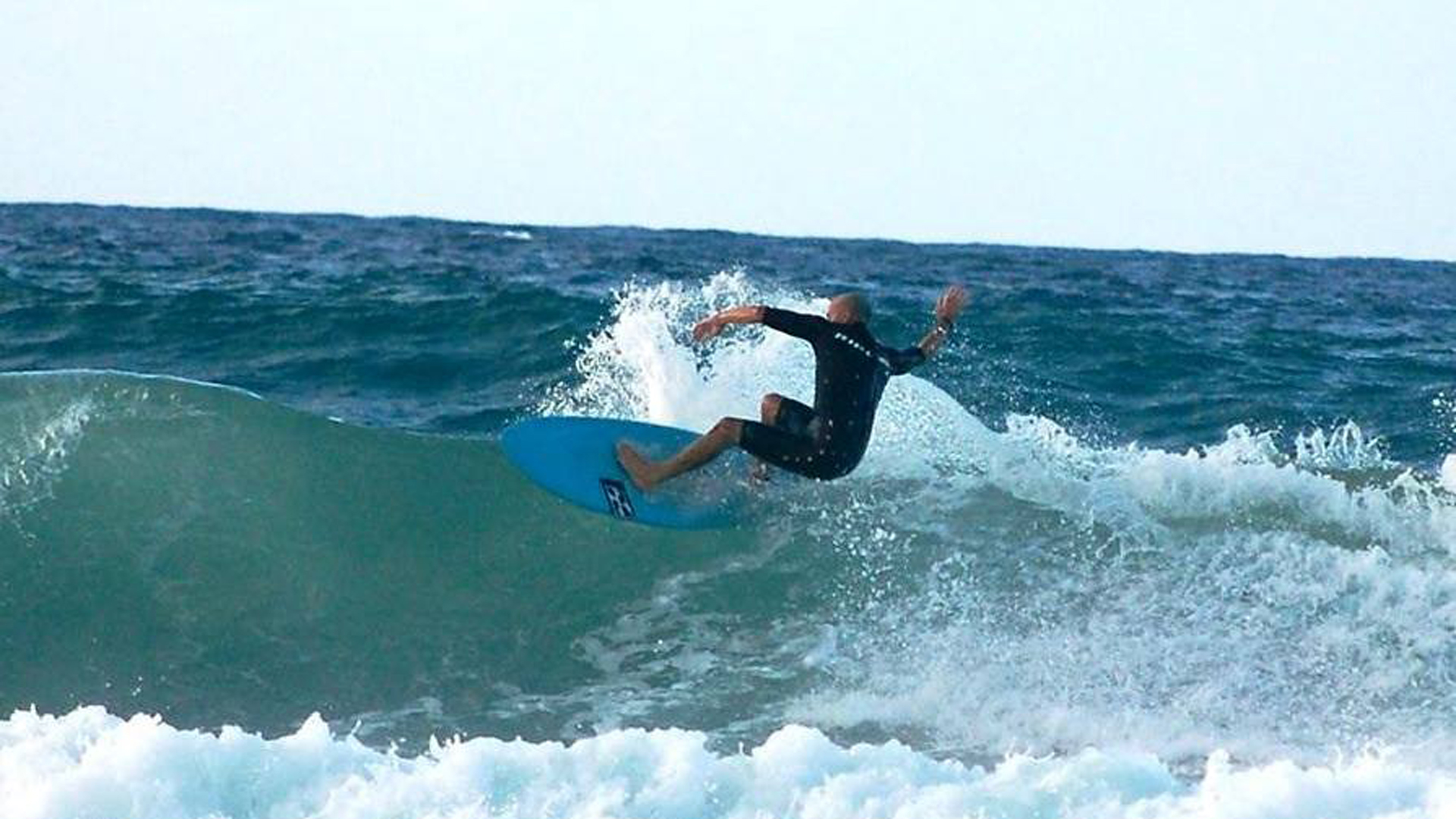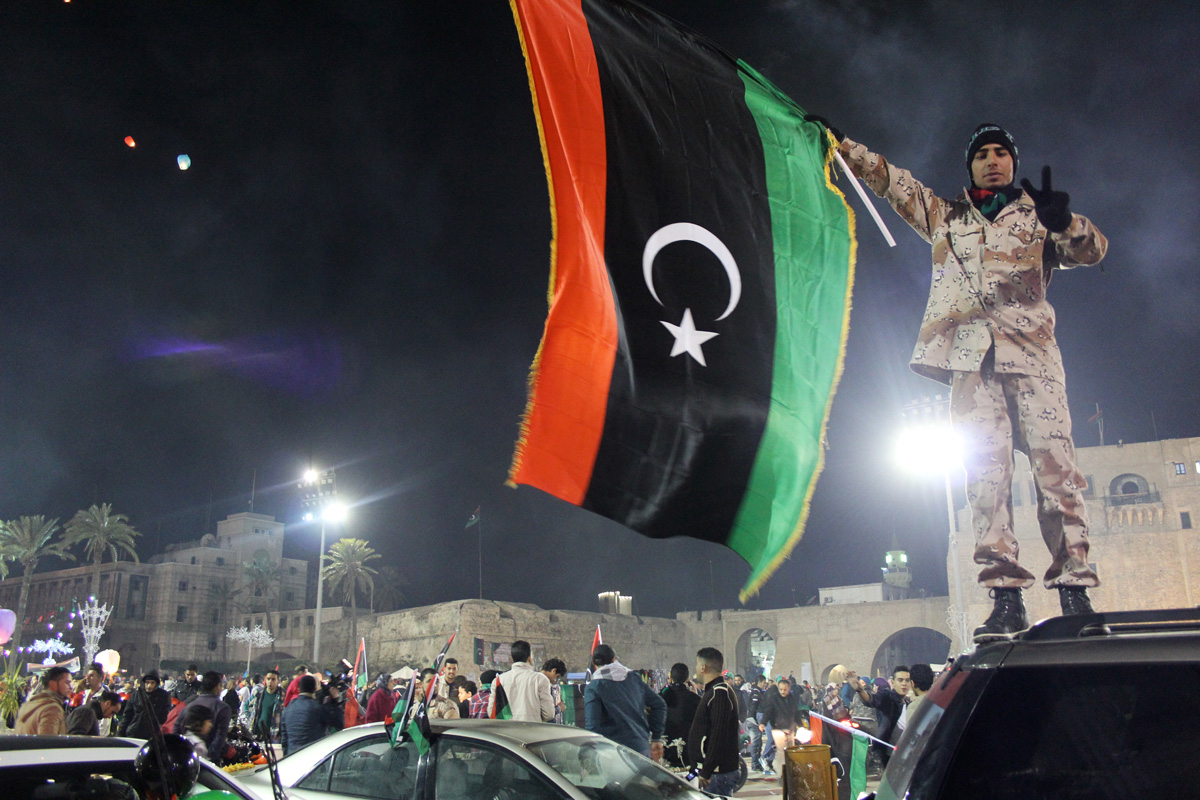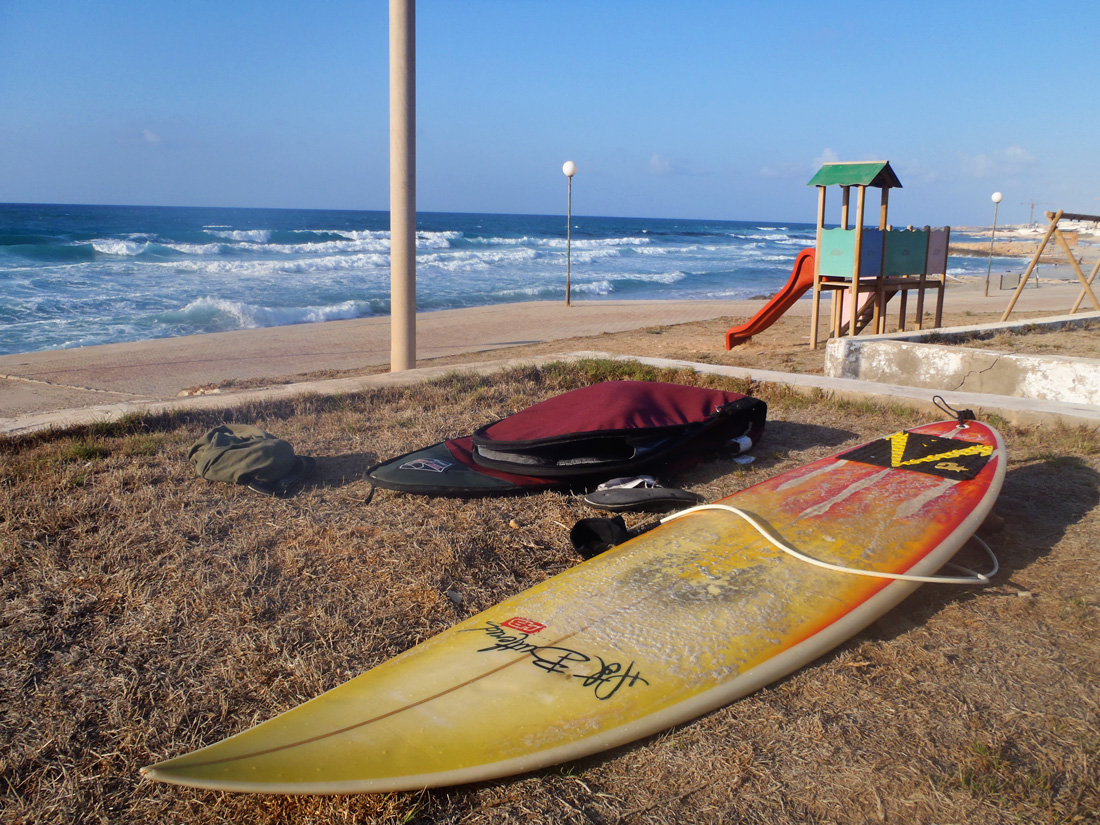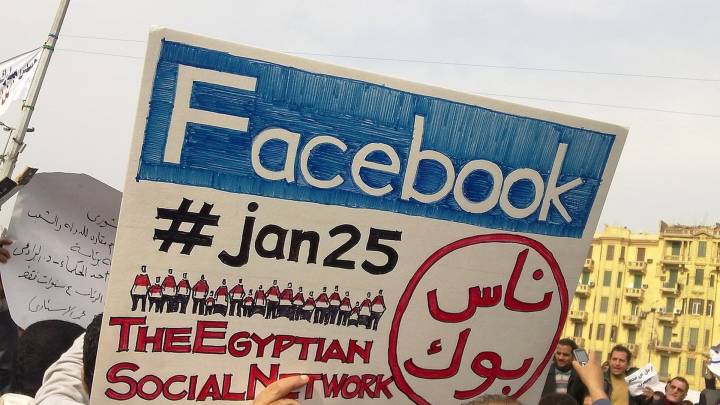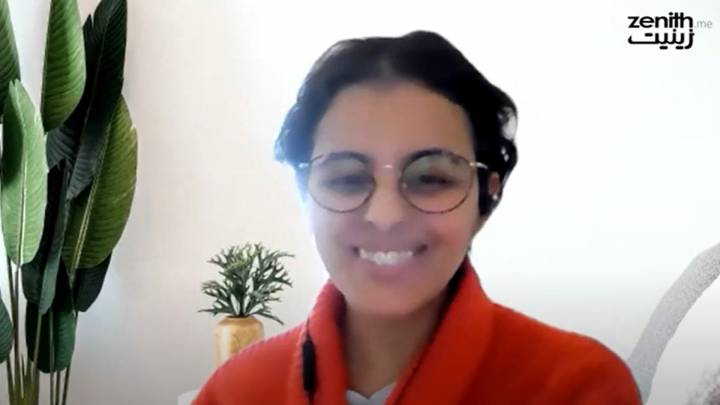Amid the optimism and chaos that followed Gaddafi's overthrow Wil Crisp explored the coastline around Tripoli and discovered an empty surfer’s playground.
The first time I saw a real swell hitting the shores of Libya, it was early February 2013, more than a year after the death of Muammar Gaddafi. I had tagged along with a friend writing a story about a post-revolutionary surge in the popularity of rugby, a sport banned under the old regime.
After spending years travelling around the crowded surf spots of France, Spain, Portugal, Sri Lanka and Indonesia, here I was in a country that could be a genuine new frontier in the surfing world.
It was a breezy, sunny day and the game was played on a grassless football pitch in what used to be a foreigners-only compound called Regatta in eastern Tripoli. Watching the former rebel fighters slamming into each other and grappling on the dusty ground in pursuit of an oval ball was a welcome distraction from the daily challenges involved in trying to follow the complex political wrangling and dramas of the country’s nascent parliament.
When the 80 minutes of violent chaos had concluded, we strolled along a coastal path back towards the car, talking about the game, when mid-conversation I realised that large waves were slamming into the rocks beside us.
As I watched the shorebreak, at least twice my height, pounding the rocks, I started to think that somewhere around here there must be a beach with waves perfect for surfing.
Grabbing hold of Hassan, a Libyan student and part-time translator for foreign journalists, I pointed to the sea and asked him how often a swell like this occurred.
“All the time in the winter,” he said, shrugging his shoulders. He didn't see the significance. It seemed like no one did.
From then on, the idea ticked away at the back of my brain. After spending years travelling around the crowded surf spots of France, Spain, Portugal, Sri Lanka and Indonesia, here I was in a country that could be a genuine new frontier in the surfing world.
I had never imagined you could surf the Mediterranean coast of North Africa. I started asking around. Did anyone know anyone who surfed here? Did anyone know where I could get a surfboard?
My initial research quickly hit a dead end. As far as I could tell, most people in Libya only had the vaguest idea of what surfing was. There seemed to be no active surfers and it was impossible to purchase a board inside the country, though there were dozens of jet ski riders and a handful of kite surfers and wind surfers.
At the time, my frivolous pursuit of waves seemed reasonable. Early 2013 was a period of optimism in Libya. There was still a fierce desire to rebuild the country, civil society was blossoming and many Libyans were relishing new freedoms that they couldn’t enjoy under Gaddafi.
There were still regular incidents of horrifying violence and the political situation was extremely fragile, but at the same time there was a consensus that the country was on its way to becoming a better place. Although there was no real police force or army, security in the country remained relatively good, thanks largely to the overflowing goodwill and euphoria that followed the end of the Gaddafi regime.
As the weeks passed and more swells rolled in, crashing on the outer reefs of Tripoli’s crowded city beaches, I still had no way of getting hold of surfing equipment. All I could do was watch the white-capped waves dance in the distance as I sat on the sand amid large families enjoying elaborate barbecues and young men having rowdy football matches.
Eventually it was time for a visa run: a return journey to London that allowed me three more months in Libya and gave me an opportunity to pick up surfing equipment from the UK.
When I returned to Tripoli that June, I came armed with a 6’1 Hot Buttered shortboard that bewildered almost everyone who saw it. On the way back from the airport, the taxi driver asked me if I used it for fishing. When I tried to explain what I actually used it for, he looked at me like I was describing the biggest waste of time imaginable.
With mid-summer approaching, decent swells were infrequent, but they still came along every once in a while. Swell forecasting websites didn’t list any surf spots for Libya or give any specific surf forecasts, but they did allow me to view swell maps of the Mediterranean that helped me to estimate when good surf might arrive.
Although I now had a board and a vague way of working out when a swell should hit, I still hadn’t located any spots where the swell hit the sand or rocks in a way that would produce good waves for surfing. I trawled the Internet for hours, but found very little useful information. The only article with any real promise that I found, ‘The Longest Wave In The Med’, was dated 19 July 2009. It depicted perfect barrelling waves and detailed a surf trip to Wadi Naga in the Green Mountains.
Unfortunately, this spot was a 1,300km drive from Tripoli in a region controlled by Ansar al-Sharia, a jihadist group that openly approved of al-Qaeda and was linked to the raid on the US embassy in September 2012 that killed Ambassador Chris Stephens.
Eventually I approached Mahmoud, a young doctor and local windsurfer, to ask whether he knew of a spot where suitable waves might break. Intrigued by my hunt for Libyan waves, he recommended Janzour Tourist Village, a resort beach in eastern Tripoli.
When the next swell started to batter the outer reefs of Tripoli’s city beaches, I grabbed my board and raced out into the dusty street to hail a taxi. After somehow jostling my board into the car, I handed the driver a piece of paper with the directions Mahmoud had written out for me.
As the taxi pulled up at our destination, the resort buildings seemed abandoned, with cracked windows and sand piled up against walls. When I asked the taxi driver whether he was sure this was the right place, he pointed at the piece of paper and nodded his head.
In a daze, I dragged my board out of the car and watched the taxi drive off. Standing in the derelict resort with my surfboard under my arm, watching the car recede into the distance, I was filled with regret. It was the only car in sight.
I warily carried my board through the dense network of small, decaying bungalows that made up the resort, weaving my way to the beach in the hot afternoon sun. The first thing I noticed was that, to my astonishment, perfect waist-high waves were rolling into the crescent-shaped bay in front of me.
The second thing I noticed was that I wasn’t alone.
Outside some of the tiny, tumble-down cottages that bordered the bay and made up the Janzour Tourist Village, there was washing hanging on lines. And right next to me, an elderly man with dark skin and a surprised expression was sitting on a chair and smoking a cigarette.
He smiled and asked me in English if I would like one. His name was Mohammed and he had been an army officer before the revolution. As we chatted, I changed into my swimming shorts, one eye on the waves that kept rolling in.
Mohammed explained that after the revolution, Janzour Tourist Village was turned into a refugee camp for Tawergans. Tawergha was a town around 200km east of Tripoli with a pre-revolution population of around 30,000, mainly black descendants of freed slaves.
During the revolution, armed rebel groups accused Tawergans of siding with Gaddafi and razed the town. Tawergha was a now a wasteland and its former inhabitants lived in refugee camps dotted around the country.
I left my bag outside Mohammed’s tiny hut, ran down the beach and paddled out. Although the waves were only shoulder-high and lacked power, they had enough punch to get my shortboard moving and provided decent rides.
Though the waves weren’t big, it felt exhilarating to be immersed in the clear water, focused on the simple process of paddling out, catching a wave and guiding the board across the face. It was a heady escape from the complexities of everyday life in Libyan society, with its dozens of fractures along the lines of tribe, race, religion and ideology, and its constant lurking threat of violence.
After surfing, I drank coffee with Mohammed and drip-dried in the sun. We watched some Arabic children playing with plastic assault rifles on the beach, laughing and wrestling in the sand. When we had both finished our coffees, he called a taxi driver friend of his to take me back to my hotel.
As summer turned into autumn, the security situation in Libya started to deteriorate. Almost a year since the first post-revolution general election, little had been done to mop up the proliferation of weapons that had flooded the country during the uprising, and almost nothing had been done to create an effective army and police force. Militias with various tribal and ideological agendas vied for power and became increasingly closely involved with the country's political processes.
In May, militias linked to the Muslim Brotherhood besieged Libya’s foreign and justice ministries and the parliament building ahead of a key vote. Five days later, parliament voted in line with their desires.
In July, former rebel leader Ibrihim Jathran turned against the central government. Calling for more independence for the country’s eastern region, Cyrenaica, he seized control of three of Libya's biggest oil export terminals, holding the country’s politicians to ransom.
Amid the erosion of the country’s democratic processes, post-revolution goodwill began to run thin and the belief of normal Libyans that the country was actually on a path to becoming a better place started to fade. Suspicion replaced optimism. Kidnappings and revenge killings increased.
In Tripoli’s market stalls, celebratory fireworks were gradually replaced by tasers and cheap Turkish handguns. Militia checkpoints popped up more frequently, and clashes between rival groups became common across the city.
I was increasingly occupied by reporting the country’s descent into chaos, but I continued to make trips to a few different beaches with occasional good waves, and I made enquiries about possible new surf spots whenever it seemed appropriate.
In October, about a week after Libya’s Prime Minister had been briefly kidnapped by a renegade armed group, Hassan told me I was not the only person surfing in Libya. He put me in touch with a UN security specialist named Sylvia, who said she often went surfing with a couple of other expats at Oea Village, a high-security compound where some of the UN offices were located. She said she could see the surf from her office window and would alert me when conditions were good.
I didn’t have to wait too long before the message came.
As my taxi approached Oea Village, the driver wove through numerous concrete barriers and endured various search procedures before dropping me off in front of the compound, which I entered on foot. Sylvia met me at the gate and told me the UN had recently increased security due to the frequent clashes between militias around the city.
After a short walk, we got to the coast, where a solid swell was rolling in. Overhead waves were unloading on a mix of sandy beach and rocky reefs, offering the potential for long rides. It was the best surf I had seen in Libya so far.
Sylvia introduced me to Hans, another UN employee, and Edoardo, an Alitalia manager, who both regularly surfed at the compound. Edoardo was the true pioneer of surfing in post-revolutionary Libya. He had been working in the country since November 2011 and had been surfing at the Oea compound, mainly by himself, for almost two years.
“A break like this would be crawling with a hundred surfers if it was off the coast of Italy,” he said. “Here we almost have the opposite problem. It’s not the crowds – it’s the lack of people to share the waves with.”
Once I made my way out to where the waves were breaking, I realised it was just one or two kilometres from Janzour Tourist Village, where I had met Mohammed and surfed in Libya for the very first time. If I looked east, I could pick out the crescent bay bordered by small white bungalows.
That day I surfed until I could barely paddle, stumbling back up the beach to collapse exhausted next to Sylvia and Hans, who were sitting at the top of the beach watching as Edoardo continued to catch waves.
As I contentedly sat in a taxi rolling back towards my hotel in central Tripoli, listening to the jangle of Libyan folk music, it felt like I had just had the first of many satisfying surfs at Oea Village.
It was the last time I surfed in Libya.
Over the weeks and months that followed, the security situation continued to deteriorate at an alarming rate as the country descended into another civil war and gunmen acted with increasing impunity.
On 5 December, Ronnie Smith, an American English teacher, was shot in the head and killed while out running in Libya’s second city, Benghazi. Less than a month later, an English man and a woman from New Zealand were murdered execution-style on a beach east of Tripoli as they had a picnic.
As the paranoia increased and the horror stories mounted, our small group of surfing enthusiasts ended up leaving the country one by one. Hans left shortly after my first surf at Oea, when his contract with the UN ended. I decided to leave in January 2014.
In July 2014, the country was rocked by a bloody month-long battle for control of Tripoli’s international airport. Both the US and UK embassies were closed and evacuated.
Sylvia and Edoardo left the country at around the same time, leaving the waves at Oea Village to roll in, unsurfed once again.
Wil Crisp is a freelance journalist based in London. He reported from Libya for the Times in the wake of the country’s 2011 uprising.

